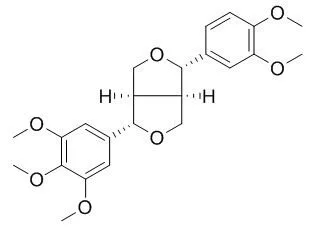| Description: |
Magnolin has anti-inflammatory, anti-histaminic, and antioxidative effects, it might be a naturally occurring chemoprevention and therapeutic agent capable of inhibiting cell proliferation and transformation by targeting ERK1 and ERK2. Magnolin can ameliorate the renal tubular necrosis, apoptosis, and the deterioration of renal function, it reduces the renal oxidative stress, suppresses caspase-3 activity, and increases Bcl-2 expression in vivo and in vitro. |
| In vitro: |
| Xenobiotica. 2011 May;41(5):358-71. | | In vitro metabolism of magnolin and characterization of cytochrome P450 enzymes responsible for its metabolism in human liver microsomes.[Pubmed: 21294626] | Magnolin is a major bioactive component found in Shin-i, the dried flower buds of Magnolia fargesii; it has anti-inflammatory and anti-histaminic activities. Incubation of Magnolin in human liver microsomes with an nicotinamide adenine dinucleotide phosphate-generating system resulted in the formation of five metabolites, namely, O-desmethyl Magnolin (M1 and M2), didesmethylMagnolin (M3), and hydroxyMagnolin (M4 and M5).
METHODS AND RESULTS:
In this study, we characterized the human liver cytochrome P450 (CYP) enzymes responsible for the biotransformation of three major metabolites--M1, M2, and M4--of Magnolin. CYP2C8, CYP2C9, CYP2C19, and CYP3A4 were identified as the major enzymes responsible for the formation of the two O-desmethyl Magnolins (M1 and M2), on the basis of a combination of correlation analysis and experiments, including immunoinhibition of Magnolin in human liver microsomes and metabolism of Magnolin by human cDNA-expressed CYP enzymes. CYP2C8 played a predominant role in the formation of hydroxyMagnolin (M4).
CONCLUSIONS:
These results suggest that the pharmacokinetics of Magnolin may not be affected by CYP2C8, CYP2C9, CYP2C19, and CYP3A4 responsible for the metabolism of Magnolin or by the co-administration of appropriate CYP2C8, CYP2C9, CYP2C19, and CYP3A4 inhibitors or inducers due to the involvement of multiple CYP enzymes in the metabolism of Magnolin. | | BMC Cancer . 2015 Aug 8;15:576. | | Magnolin inhibits cell migration and invasion by targeting the ERKs/RSK2 signaling pathway[Pubmed: 26253302] | | Abstract
Background: Magnolin is a natural compound abundantly found in Magnolia flos, which has been traditionally used in oriental medicine to treat headaches, nasal congestion and anti-inflammatory reactions. Our recent results have demonstrated that Magnolin targets the active pockets of ERK1 and ERK2, which are important signaling molecules in cancer cell metastasis. The aim of this study is to evaluate the effects of Magnolin on cell migration and to further explore the molecular mechanisms involved.
Methods: Magnolin-mediated signaling inhibition was confirmed by Western blotting using RSK2(+/+) and RSK2(-/-) MEFs, A549 and NCI-H1975 lung cancer cells, and by NF-κB and Cox-2 promoter luciferase reporter assays. Inhibition of cell migration by Magnolin was examined by wound healing and/or Boyden Chamber assays using JB6 Cl41 and A549 human lung cancer cells. The molecular mechanisms involved in cell migration and epithelial-to-mesenchymal transition were determined by zymography, Western blotting, real-time PCR and immunocytofluorescence.
Results: Magnolin inhibited NF-κB transactivation activity by suppressing the ERKs/RSK2 signaling pathway. Moreover, Magnolin abrogated the increase in EGF-induced COX-2 protein levels and wound healing. In human lung cancer cells such as A549 and NCI-H1975, which harbor constitutive active Ras and EGFR mutants, respectively, Magnolin suppressed wound healing and cell invasion as seen by a Boyden chamber assay. In addition, it was observed that Magnolin inhibited MMP-2 and -9 gene expression and activity. The knockdown or knockout of RSK2 in A549 lung cancer cells or MEFs revealed that Magnolin targeting ERKs/RSK2 signaling suppressed epithelial-to-mesenchymal transition by modulating EMT marker proteins such as N-cadherin, E-cadherin, Snail, Vimentin and MMPs.
Conclusions: These results demonstrate that Magnolin inhibits cell migration and invasion by targeting the ERKs/RSK2 signaling pathway. |
|
| In vivo: |
| Oxid Med Cell Longev. 2014;2014:203458. | | Magnolin protects against contrast-induced nephropathy in rats via antioxidation and antiapoptosis.[Pubmed: 25400863] | Magnolin is the major active ingredient of the herb Magnolia fargesii which has anti-inflammatory and antioxidative effects. Oxidative stress and apoptosis are involved in the pathogenesis of contrast-induced nephropathy (CIN). We hypothesize that Magnolin could protect against CIN through antioxidative and antiapoptotic properties.
METHODS AND RESULTS:
To test whether Magnolin could attenuate CIN, oxidative stress and apoptosis, in vivo and in vitro, we utilized a rat model of ioversol-induced CIN and a cell model of oxidative stress in which HK2 cells were treated with H2O2. Rats were assigned to 4 groups (n = 6 per group): control group, ioversol group (ioversol-induced CIN), vehicle group (CIN rats pretreated with vehicle), and Magnolin group (CIN rats pretreated with 1 mg/kg Magnolin).
The results showed that Magnolin ameliorated the renal tubular necrosis, apoptosis, and the deterioration of renal function (P < 0.05). Furthermore, Magnolin reduced the renal oxidative stress, suppressed caspase-3 activity, and increased Bcl-2 expression in vivo and in vitro.
CONCLUSIONS:
Magnolin might protect CIN in rats through antioxidation and antiapoptosis. |
|






 Cell. 2018 Jan 11;172(1-2):249-261.e12. doi: 10.1016/j.cell.2017.12.019.IF=36.216(2019)
Cell. 2018 Jan 11;172(1-2):249-261.e12. doi: 10.1016/j.cell.2017.12.019.IF=36.216(2019) Cell Metab. 2020 Mar 3;31(3):534-548.e5. doi: 10.1016/j.cmet.2020.01.002.IF=22.415(2019)
Cell Metab. 2020 Mar 3;31(3):534-548.e5. doi: 10.1016/j.cmet.2020.01.002.IF=22.415(2019) Mol Cell. 2017 Nov 16;68(4):673-685.e6. doi: 10.1016/j.molcel.2017.10.022.IF=14.548(2019)
Mol Cell. 2017 Nov 16;68(4):673-685.e6. doi: 10.1016/j.molcel.2017.10.022.IF=14.548(2019)